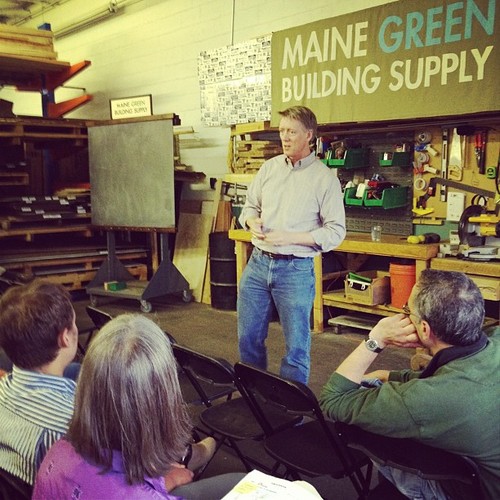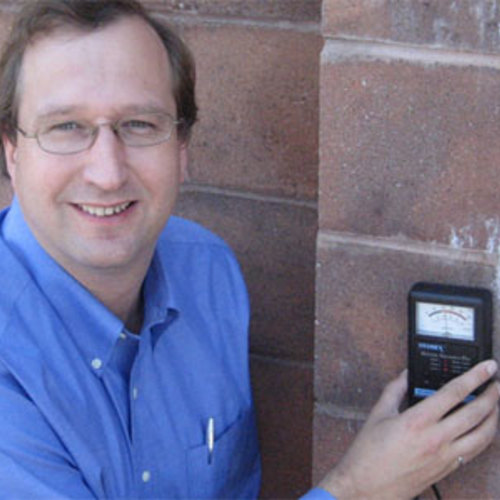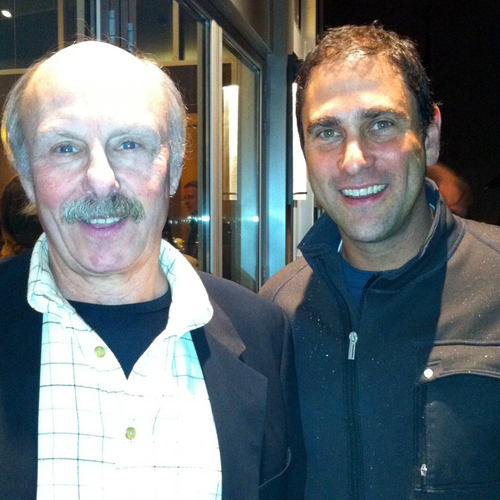*3 parts Irish whiskey
*1 part Kahlua
*1 maraschino cherry
Shake with ice, strain into a chilled glass
You know how occasionally the comments section that follows certain blogs drifts off into “Big Picture” territory? When we do a podcast on something simple like air sealing or home energy monitoring, for some reason someone has to bring up population control, lack of focus on urban retrofits, or how Frank Loyd Wright was a racist. (For the record, I’m not trying to bring that one up again—so let’s leave it alone, please.)
Anyway, this one’s for you, “Big Picture People.”
Phil and I were very pleased to have James Howard Kunstler on for a discussion about where we’re headed as a nation and the role we architects, designers, and planners play.
The Highlights
A Black Irish: Our drink (due to a last-minute change of plans). While recording, we wondered if this is a racist or slanderous term. Even after Googling it, I’m still not certain. We mean no offense. It’s a black drink (Kahlua added to Irish whiskey).
What’s going to hit us first: the downfall of our global economy or the end of cheap oil? After some discussion, Jim seems to lean toward economic downfall, given recent history.
Is the Occupy Wall Street movement going to have an effect? Jim discusses how the seed has been planted. Regardless of what happens, if anything, it has entered the consciousness of our culture.
Is “green” a real movement? It began as a genuine movement, but Jim talks about its history and its co-option.
New Urbanists vs. landscape-as-artists. Plenty of name-dropping (and name-calling) here. Good stuff.
Who’s got a good bead on the right path forward? The New Urbanists, who are trying to correct the poor choices our society has been making for decades. The details are fascinating.
Jim’s place. Phil and I were curious about where and how a guy with such dynamic visions for the future chooses to live.
What’s the public’s impression of architects? We discuss the architect’s “PR problem.”
What would Jim tell the architects and builders out there? We don’t need more “mystifying” buildings. And also, no more skyscrapers. A green skyscraper is a contradiction in terms, and possibly not for the reasons you’d imagine.
Is there an architect out there doing great work? New Urbanists like Victor Dover. Jim explains why.
Are any of our leaders on the right track? For Jim, one economist came to mind: Laurence Kotlikoff , of Boston University. Political leadership is failing. Architecture is failing (e.g., Rem Koolhaus’s “prank” on Harvard). Jim likens our current condition to that of the late 1850s. He explains.
Will technology save us or bury us? Jim talks about his upcoming book, Too Much Magic, and the concepts behind this tenuous relationship with technology and the drastic mistakes we’re making.
Be sure to visit James Howard Kunstler’s web page. There you can find links to his blogs, books, articles, paintings, and podcast. (If you subscribe to ours, chances are more than likely you’ll enjoy his as well.) Phil and I are especially fond of his Eyesore of the Month blog. Be sure to check it out. He also has a nice TED Talks Presentation, wherein he dissects suburbia. And of course he had a nice appearance on The Colbert Report.
As usual, Phil shares a song at the end that he believes we should be listening to in the studio. This episode it’s “Holy Holy” by Wye Oak.
The official transcript
of the show is available to GBA PRO members. To become a member (or to take a free 10 day trial), go to the member sign up page.
Weekly Newsletter
Get building science and energy efficiency advice, plus special offers, in your inbox.















5 Comments
Trigger finger reflex.
Chris and/or Phil,
Nice interview.
But whoever was working the "beep" button needs practice ;-)
Woops!
Whoa! We have a technical error. Not sure what happened. We must have the pre-beep recording up accidentally. I'll get on it and we'll get it fixed. In the mean time, you should all be warned that there's a few grown-up word on here. Sorry Mom.
Chris
Bleeps are back
The Blue hour is over and the bleeps are back in. Sorry about that. Sheila wants me to make sure you all know that one was my fault.
Chris
Big picture
In relation to the design of cities, great American cities, and generally for those of you who are readers:
I'm reading the 1974 biography of Robert Moses, by author Robert Caro, called The Power Broker. If there is one book, on the big picture worth reading, it is that one. Those of you, who prefer a short video interview with the author, can take a look at Richard Heffner's Open Mind web site at Thirteen dot org, where Caro describes the thinking behind the 1974 award winning bio, and his more recent three volume series on president L.B. Johnson.
I am sure that both Chris and Phil, would greatly enjoy reading this book. It's a huge book, but it's quite easy reading, and Robert Caro is a really entertaining writer. I'd love to have a real drink some day, with the Architect's Lounge members - some day, when they have finally read Caro's bio.
An ex. master builder writes an economics paper
Hi guys,
On the topic of wide discussion and everything, I received a brief for my economics module at Limerick Institute of Technology this year, to explain everything from Noah's Ark, to the present day, in 6,000 words - and why it all went wrong. I think I succeeded in achieving some parts of that assignment, in just under 10,000 words. It took me about two hours to read, the last time I read the final draft yesterday before assignment handup.
Anyhow, I think it is a pretty rare artifact, in being an academic paper about economics, written by an ex. builders and architect. But heh, what are Great Recessions for? All the best, B.
http://www.scribd.com/doc/83196623/Cyclical-Trends-BOH-v04
Log in or create an account to post a comment.
Sign up Log in